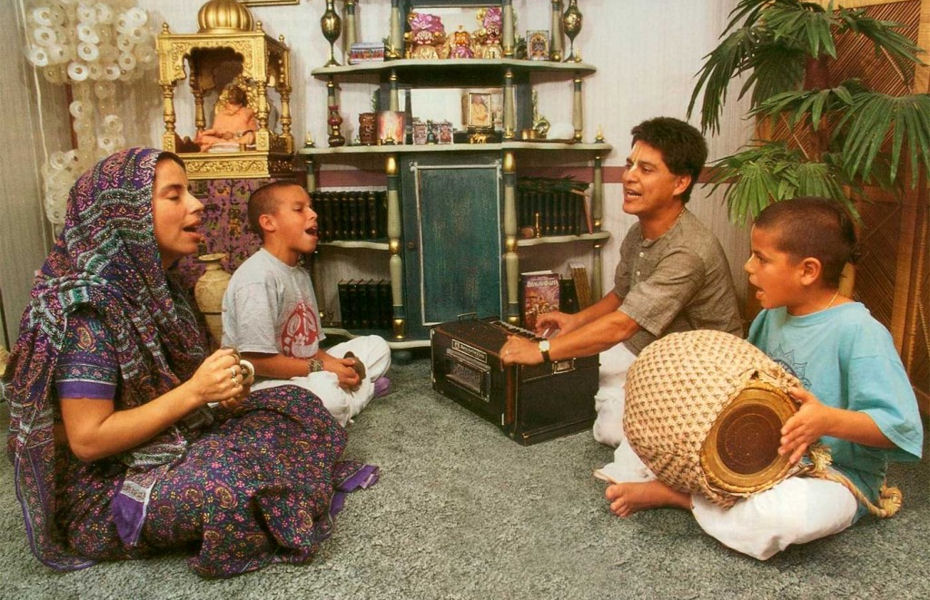Elevating Householder Life for Ultimate Fulfillment
In our daily lives, we often get caught up in routines, career ambitions, family obligations, and societal expectations. The modern world presents us with a multitude of topics to explore—science, politics, economics, and entertainment. Yet, behind this busyness, there lies a subtle, deep truth revealed in Srimad Bhagavatam (2.1.2): human life is ultimately meant to address the existential challenges we all face, namely birth, death, old age, and disease. For the spiritually inclined, the shift from being a grihamedhi (materially engrossed householder) to a grihastha (a true householder on the path of self-realization) represents an important, life-changing transition that brings profound fulfillment and purpose. This blog post aims to highlight the differences between these two roles and invites readers to take active steps toward embodying the transformative grihastha way of life.
Understanding Grihamedhi and Grihastha
In Sanskrit, there are two terms associated with householder life: grihamedhi and grihastha. Both relate to family life, but their fundamental motivations are vastly different.
- Grihamedhi: This term refers to someone who lives with family solely for material pursuits and personal comfort. The grihamedhi lifestyle revolves around fulfilling family and social obligations but remains limited to material pleasures. It often leads to jealousy, competition, and endless desires. While grihamedhis stay entangled in worldly pursuits, they are “blind to the knowledge of ultimate truth.” Their hearing is consumed by the transient—topics of the world—rather than the eternal truths that free one from material bondage.
- Grihastha: In contrast, the grihastha sees family life as a spiritual duty and an opportunity to grow in God consciousness. Unlike the grihamedhi, the grihastha is not bound by material life but lives with a higher purpose, balancing responsibilities with spiritual practices. Their life revolves around devotion and the pursuit of truth, using family as a supportive environment for realizing God’s presence. In other words, grihastha life is a yajna (sacrifice), offered in gratitude to the Divine.
This dual understanding of householder life gives us insight into why many householders today feel unfulfilled. True happiness eludes the grihamedhi because, although engaged in family life, their vision is limited to immediate, worldly concerns, while the grihastha aligns each activity with a deeper spiritual goal.
Why Shift from Grihamedhi to Grihastha?
- Inner Peace Over Outer Prosperity: The pursuit of material wealth and status alone cannot provide lasting peace. As a grihastha, one finds peace within, anchoring their life to eternal spiritual truths rather than temporary gains.
- Freedom from Envy and Competition: The grihamedhi’s life is marked by jealousy and comparison, whether at the level of family, community, or nation. In grihastha life, however, householders become collaborators, not competitors. As they grow in spiritual wisdom, their relationships are filled with compassion and understanding.
- Higher Fulfillment: Material life has an insatiable hunger; no matter how much we acquire, we crave more. Shifting to grihastha life satisfies the heart’s deeper longing for divine connection, which no amount of wealth or prestige can fulfill.
- A Legacy Beyond Wealth: The grihamedhi often views success as material inheritance. But grihasthas inspire their children and communities by embodying integrity, devotion, and values. They leave a legacy of wisdom and virtue that transcends generations.
How to Transition to a Grihastha Life
Here are practical ways to shift from a grihamedhi lifestyle to the enriching life of a grihastha:
- Regular Spiritual Practice: Cultivate a daily practice of sadhana, which may include chanting, prayer, and reading sacred texts. Setting aside even 15–30 minutes a day builds a strong foundation for spiritual life. When family members join, this becomes a collective upliftment.
- Dedicate Your Home to God: Make your home a place of worship and spiritual discussion. Establish a small altar with sacred images, and offer your food to God. These simple acts transform a house into a holy space.
- Practice Gratitude in Relationships: A grihastha honors family members as gifts from God and treats them with love and respect. Gratitude cultivates harmony, dissolving the envy and competition often present in grihamedhi life.
- Choose Meaningful Content to Hear and Discuss: Srimad Bhagavatam reveals that hearing about the Supreme Lord—His name, form, and pastimes—is the ultimate means to purify consciousness. Instead of constantly discussing material subjects, bring spiritual wisdom into your conversations. Participate in reading groups or join devotional communities that foster spiritual topics.
- Develop Compassion Beyond the Family Circle: While a grihamedhi focuses solely on family welfare, the grihastha extends love and support to others. Helping the less fortunate or contributing to community welfare aligns your family with selfless principles.
Cultivating a Grihastha Lifestyle: Practical Ideas
Let’s dive deeper into daily practices and actions that can help establish a grihastha life:
- Morning Devotion: Begin your day with a few moments of prayer or reflection. Meditating on gratitude or reciting slokas brings divine grace into the day.
- Offering Food as a Sacrifice: Cooking becomes an act of devotion when we prepare food with love and offer it to God before eating. This simple act purifies our minds and harmonizes family meals with divine energy.
- Regular Family Study: Choose one night a week to study scriptures or spiritual books together. This opens channels for meaningful conversation and bonds family members in spiritual growth.
- Focus on the Eternal in Conversations: While work and practical matters need attention, dedicate part of your time to discussing soul-enriching topics. Engage in conversations about purpose, values, and spiritual learning with family, encouraging deeper connections.
- Service to the Greater Community: Engage as a family in activities that help others. Whether volunteering, donating, or teaching spiritual practices, serving others brings joy and meaning to life, reducing self-centeredness.
The Ultimate Goal: Returning to Our Eternal Home
Grihastha life leads us on a path back to Godhead, a return to our true spiritual home where the cycle of birth, death, and disease ceases. The material world presents endless distractions, and as grihamedhis, we risk becoming entangled. However, by embracing grihastha life and following the guidance of enlightened sages, we move closer to the ultimate goal—transcendental love and union with God.
In the Bhagavad-gita (8.16), Lord Krishna declares, “From the highest planet in the material world down to the lowest, all are places of misery wherein repeated birth and death take place. But one who attains to My abode, O son of Kunti, never takes birth again.” This promise is for everyone, regardless of family or social responsibilities, provided we orient our lives towards God. The grihastha lifestyle is not renunciation but transformation, an opportunity to sanctify family life with divinity.
Call to Action: Embark on the Journey Today
The journey from grihamedhi to grihastha is a call to step into a life of true purpose and fulfillment. It is a reminder that family life can be an avenue for spiritual growth, rather than just a pursuit of material satisfaction. To start, let’s take a small but powerful step toward spiritual living:
- Dedicate time each day to God.
- Make family meals sacred by offering them.
- Prioritize spiritual discussion over mundane topics.
- Serve others together as a family.
By embracing these practices, we will transform our homes from mere dwellings into sanctuaries of peace and spiritual wisdom. We have the choice today to elevate our family life from material entanglement to divine fulfillment. The path of the grihastha awaits; let us take that step together, back to our eternal home





